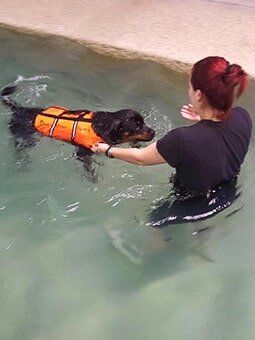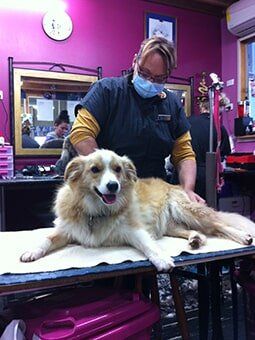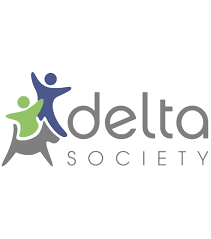Canine Therapy
Canine Hydrotherapy Helps Recovery
Swimming is an ideal means of ensuring your dog's fitness, improving recovery from injury or illness and is very beneficial for your dog's long-term health and wellbeing. Just like with humans, swimming allows nearly all muscles to be exercised without the impact concussion of walking or running.
Pool Specially Designed For Dogs
Dogoverboard's very large in-ground heated swimming pool is specially designed for therapy dogs. The pool is a 15m indoor pool with purpose built walk-in side ramp to allow all size dogs easy entry and exit from the pool. It is the only dog specific in ground public pool in NSW. The pool is heated to 24℃ and filtered all year round. The pool water is quality controlled and is hygienically cleaner than required for domestic pools. Dogs benefit from swimming in heated water as distinct from cold ocean or lake water, as cold water for dogs can cause constriction of the blood vessels near the skin and to the superficial muscles.
Hydrotherapy
For dogs with medical conditions, that are restricted by normal concussive weight bearing exercise, swimming is vital exercise for muscles and the cardiovascular system. Swimming is ideal exercise for dogs recovering from operations or those requiring non-stressful exercise for painful joints, bone and muscle disorders. To assist therapy, some owners happily swim with their dogs. If you are not confident, our trained staff can be booked to assist with hydrotherapy.
Exercise Without Stress
Swimming helps to improve general fitness and stamina, improves muscle tone and assists recovery from injury or operation without any restrictive stress on the dog's body. Stronger toned muscles help protect dogs against injuries sustained during normal impact exercise such as running or jumping for balls. For a dog a 5 minute swim is equivalent to a 5 km run.
Weight Loss and Swim Exercise
For dogs that are overweight or cannot be exercised regularly, swimming provides supportive high return low-impact exercise. It is difficult and sometimes unhealthy to give an overweight dog sufficient low-impact exercise on land without over stressing bones, joints and the cardiovascular systems of the dog. A controlled build-up of swimming provides dogs with ideal exercise to assist fitness and compliment diet management for weight loss.
Drop In and Check Us Out
The swimming pool is open 7 days a week and is an off-leash area. If you supervise your dog, whether for fun or therapy, you do not need to book. Just drop-in any time. The pool rules are simple. The dog and owner must have fun. The owner must supervise the dog within the large pool enclosure. You share the pool with other doggy swimmers.
Assistance buoyancy vests are available for hire or purchase. Lead poles are provided to assist in directing the swimming dog around the pool. The pool can be exclusively booked for hydrotherapy or fun use for an additional half-hourly charge.
Canine Massage & Canine Myofunctional Therapy
Cheryl Shaw the owner of Dogoverboard was the first Companion Animal Hygienist (CAH) and Pet Stylist to be qualified as a Canine Masseur and as a Canine Myofunctional Therapist in NSW. She carries out therapy sessions at Dogoverboard by appointment only.
Canine Massage
Canine massage benefits dogs in the same way massage benefits humans. It not only stimulates and relaxes your dog, it helps to speed-up the healing process for specific injuries and prevent future injury. Massage can increase circulation which in turn assists in healing and maintaining the strength and tone of muscles, improving restricted range of movement by relaxing and loosening muscle fibres and improving the strength and flexibility of muscles to help prevent future injury. Massage can also relieve pain by easing swelling or tension during recovery, can calm nervous dogs and maintain the fitness of dogs involved in showing and in working dogs. Older dogs with hip, joint and muscle problems can benefit from regular massage. It is an ideal way of relieving pain in sore joints and providing ongoing pain relief. Massage is an ideal means of balancing the dog's mind and body. Once the dog gets used to the massage, it will really enjoy the experience. Dogs relax and calm down when massaged and it is obvious to all that it is a pleasurable experience for the dog and masseur.
Canine Myofunctional Therapy (CMT)
Canine Myofunctional Therapy (CMT) is a non-medical way of managing problematic physical aspects of canine health. CMT involves the therapist first identifying and then treating the dog's ailments by applying various forms of massage and stretching. This form of therapy promotes healthy muscles, tendons and joints while reducing levels of pain and stress for the dog.
What is Involved in CMT?
A typical session begins with our therapist, Cheryl, assessing the dog, taking into account the dog's medical history as provided by the owner. Cheryl will carefully observe and identify aspects of "asymmetry" in the dog's body. Observations of gait, stance, posture and alignment are especially important. Once the sites requiring attention have been identified, various techniques of massage and stretching are applied. The application of massage helps to balance the body's metabolism or "homeostasis" by aiding the major complex working systems such as circulatory, "respiratory", "digestive", "nervous" and "urinary" systems, which help the body to function efficiently as a whole. As a result of CMT, blood supply is increased, "temperature" is regulated, bodily waste products are expelled, levels of oxygen are increased, carbon dioxide is decreased and the uptake of food into fuel for the body is maximised.
On average the first therapy consultation takes around an hour, taking in the history of the dog, making observations and time for the dog to get to know the therapist. Then the therapist proceeds with CMT which includes massage, stretches, and rotations. Depending on the dog, fortnightly treatments are recommended at first, then monthly depending on the progress. CMT appointments are allocated during quiet times of the day when there are fewer distractions for the dog. Clients are often sent home with basic massage moves to help improve their dog between appointments.
The Benefits of Canine Massage & CMT
Canine massage and/or CMT helps to promote and increase blood flow to muscles that might be painful, which reduces the risk of oedema. Practicing CMT on a dog diverts fresh blood to the ailing region which in turn increases the levels of oxygen and decreases the possibility of swelling. Additionally, this assists the body to improve the elasticity of tissue fibres which facilitates an increased range of movement. Other benefits of massage include releasing "scar tissue and tight tendons", relieving "spasms, strains and sprains" and maximising the dog's physical condition and fitness. Improved muscle condition is apparent, secondary health and wellbeing benefits result as a flow on effect. The whole of the dog benefits, which augurs well for a holistic treatment.
As a relevant example of the benefits of CMT, dogs who suffer from hip dysplasia have extremely limited muscle movement, possible atrophy and experience pain. CMT is used to increase the flow of blood into the muscles flushing out toxins and improving the health of the muscle fibres. In this case the therapist would focus on areas incorporating the sartorial, tensor muscle of fascia lata, femoral biceps and the semitendinous muscles. By massaging and stretching these areas the dog's range of movement will be increased, which will result in the curtailing of atrophy. This in turn will facilitate the dog's ability to rebuild the injured muscle fibres via a related increase in exercise. As a result, this treatment addresses not only the physical aspects of the dog's condition but also positively addresses lifestyle aspects such as increased flexibility and lessening of pain.
Holistic Health Framework
Canine massage and CMT is an important aspect of a holistic health framework for dogs and compliments many other lifestyle options including good nutrition and exercise. These also work towards keeping the fibres of the muscles in peak condition, whilst lowering the risk of muscle wastage. In addition to good nutrition, many veterinary surgeons suggest regular safe swimming or canine hydrotherapy as this type of non-weight bearing exercise is a very safe complimentary treatment.
Appointments are Necessary
Dogoverboard's therapy treatments are available 6 days a week, Monday to Saturday. Appointments are necessary and should be booked in advance.









